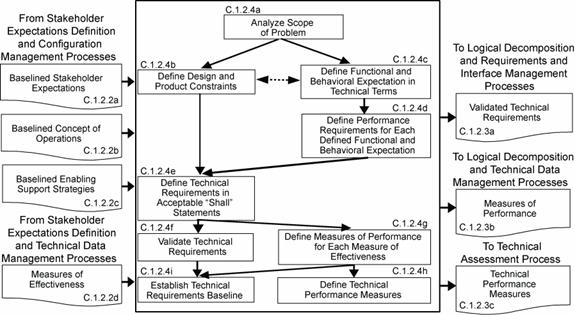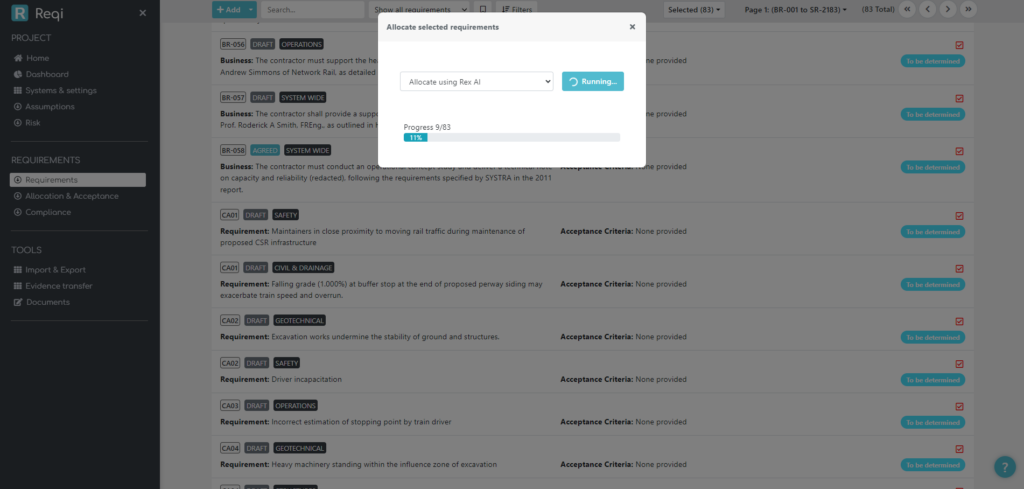In the intricate symphony of system development, requirement allocation stands as a pivotal conductor, orchestrating a harmonious integration of technical constraints, stakeholder expectations, and functional necessities. This fundamental process embodies more than just the sequential arrangement of tasks; it is the strategic art of translating abstract visions into concrete, actionable objectives. The essence of requirements allocation hinges on its capability to bridge the chasm between high-level aspirations and the granular specifics of system architecture and design.
At its core, requirement allocation serves as the backbone for ensuring clear responsibilities among the diverse members of a systems engineering team. By meticulously managing the complexity inherent in sophisticated systems, allocation paves the way for a balanced approach to negotiating the inevitable trade-offs between competing demands. Moreover, it enhances the traceability and accountability essential for the rigorous analysis, validation, and verification processes pivotal to system development.
Why, one might ask, is there such a pronounced emphasis on the allocation of requirements? The answer lies not just in the pursuit of operational effectiveness, but in the quest for resilience and adaptability. In the dynamic landscape of technological evolution, the capacity to gracefully navigate changing conditions, stakeholder interests, and emerging challenges is invaluable. Requirement allocation, therefore, is not merely a procedural necessity; it is a strategic imperative that empowers teams to craft solutions that are robust, scalable, and aligned with the ethos of continuous improvement.
As we delve into the subsequent sections, we will unravel the complexities of allocating requirements, from the derivation of measurable objectives and the negotiation of constraints to the decisive act of architectural determination. With an emphasis on collaborative decision-making, the role of stakeholders, and the imperative of balancing diverse interests, this article aims to illuminate the multifaceted nature of requirement allocation. Through a comprehensive exploration of its principles, practices, and emerging trends, we stand on the cusp of elevating system development to new heights of excellence and innovation.
Table of Contents
Importance of Requirement Allocation in System Development
The centrality of requirement allocation in the ecosystem of system development cannot be overstated. It is the linchpin that secures the integrity, functionality, and success of the system in question. Let’s delve into the critical roles that requirements allocation plays in the broader schema of system engineering.
Ensuring Clear Responsibilities
One of the paramount benefits of meticulous requirement allocation is the establishment of clear, unambiguous responsibilities among the project team. By distinctly outlining who is accountable for what, teams can operate with heightened efficiency and cohesion. This clarity fosters a productive work environment, minimizes overlaps and gaps in the development efforts, and sets a clear path for progression.
Managing Complexity
Modern systems often embody staggering levels of complexity, integrating multifarious components, technologies, and functionalities. Requirement allocation acts as a compass that guides the team through this labyrinth of complexity, breaking down overarching goals into manageable, coherent units. By distributing these units strategically, teams can tackle the system’s complexity piece by piece, ensuring thoroughness and precision in development.

Balancing Trade-offs
In the realm of systems engineering, trade-offs are an unavoidable reality. Cost, time, quality, and functionality often pull development in different directions, demanding compromises. Requirement allocation facilitates a structured platform for negotiating these trade-offs, enabling teams to make informed decisions that balance these competing demands optimally. This balance is critical for developing systems that meet stakeholder needs within practical constraints.
Pre-Allocation Activities
Before diving into the task of allocating requirements within a system development process, there are several critical activities that must be undertaken to lay a solid foundation for success. The following table outlines essential pre-allocation activities, each accompanied by a description to highlight its importance and role in preparing for an effective requirement allocation. These foundational steps are instrumental in ensuring that the allocation process is smooth, efficient, and aligned with both stakeholder expectations and the system’s architectural framework.
| Pre-Allocation Activity | Description |
|---|---|
| Stakeholder Engagement | Gather inputs and feedback from all relevant stakeholders to ensure their needs and expectations are understood and considered in the system’s requirements. |
| Agreed Systems Architecture | Finalize and obtain consensus on the system architecture to ensure that the allocation of requirements is consistent with the architectural decisions. |
| Review of Requirements | Conduct a thorough review of the gathered requirements to ensure they are complete, unambiguous, and free of conflicts. |
| Consolidation of Requirements | Combine and organize requirements to eliminate redundancies and ensure a coherent set of requirements that can be systematically allocated. |
| Priority Assignment | Assign priorities to the requirements based on stakeholder importance, technical necessity, risk assessment, and other relevant criteria to guide the allocation process. |
| Identification of Constraints | Identify and document any constraints (technological, legal, budgetary, etc.) that could impact the allocation of requirements. |
| Development of Allocation Strategy | Devise a strategy for the allocation process that considers the project’s priorities, constraints, and the system architecture. |
| Verification of Requirement Validity | Ensure that all requirements to be allocated are verified for validity and feasibility within the agreed system architecture and constraints. |
Enhancing Traceability and Accountability
A robust requirement allocation process bolsters traceability and accountability throughout the system’s life cycle. It enables teams to meticulously trace each requirement from its origin through to implementation and verification, ensuring that nothing falls through the cracks. Such traceability is invaluable for maintaining the integrity of the development process, facilitating audits, and meeting regulatory benchmarks. Furthermore, it underpins the accountability framework, as each requirement is clearly linked to specific entities or individuals.
Analyze and Allocate Requirements
The journey of requirement allocation begins with the extraction of explicit, quantifiable objectives from the often nebulous stakeholder needs and expectations. These measurable requirements are the bedrock upon which the entire development effort is founded. They provide a clear, objective yardstick against which progress can be measured and validated.
Constraints and Considerations
The allocation process is invariably influenced by a spectrum of constraints – be they technological, financial, or operational. These constraints frame the boundaries within which the system must be developed. Understanding and incorporating these considerations from the outset is crucial for realistic and feasible requirement formulation.
Derivation and Decomposition
This stage involves breaking down high-level requirements into more granular, specific objectives that can be allocated to different components or aspects of the system. Decomposition fosters precision and manageability, allowing for a more targeted approach to development.
Linking Requirements and Supporting Bases
Every allocated requirement must be anchored to a rationale, a justification that elucidates why it exists and how it contributes to the system’s overarching goals. This linkage ensures that the system remains aligned with its intended purpose and stakeholder expectations.
Demonstrating Requirement Validity
The allocation process must also encompass mechanisms for validating the derived requirements. This entails verifying that they are realistic, achievable, and aligned with the system’s intended outcomes.
Validating Requirements
Finally, a companion process to allocation is the ongoing validation of requirements. This involves ensuring that the requirements and their respective allocations continue to be relevant and conducive to the system’s objectives, especially as conditions and understandings evolve.
Through these meticulous steps, requirement allocation serves as the cornerstone of effective system development, guiding teams through the maze of complexities and challenges towards the ultimate goal of delivering a system that meets, if not exceeds, expectations.
| Step | Supporting Information and Tips |
|---|---|
| Deriving Measurable Requirements | Engage directly with stakeholders to clarify needs and expectations. Utilize SMART criteria (Specific, Measurable, Achievable, Relevant, Time-bound) to ensure requirements are actionable. Consider using tools for requirements gathering and analysis, such as surveys or facilitated workshops. |
| Constraints and Considerations | Perform a comprehensive review of technological, legal, and operational constraints early in the process. Use checklists or frameworks to systematically identify potential constraints that might impact requirement allocation. |
| Derivation and Decomposition | Break down high-level requirements into smaller, more manageable components using techniques like functional decomposition. Ensure each decomposed requirement retains traceability to its parent requirement for accountability and tracking. |
| Linking Requirements and Supporting Bases | Document the rationale behind each requirement to provide context and justification for design decisions. Utilize requirements management tools to maintain a clear linkage between requirements, their rationale, and the corresponding system architecture elements. |
| Demonstrating Requirement Validity | Conduct early prototype testing or simulations to validate the feasibility and relevance of requirements. Engage domain experts to review and confirm the technical and operational validity of requirements. |
| Validating Requirements | Develop a structured validation plan that outlines methods, criteria, and schedules for validating requirements throughout the development process. Incorporate feedback from validation activities to refine and adjust requirements as necessary. |
Measuring the Requirements Allocation Capacity within a System of Systems
The intricacies and expansive nature of developing a System of Systems (SoS) introduces unique challenges, particularly when it comes to the process of requirement allocation. Unlike traditional system development, where the focus is often on a singular, cohesive system, SoS involves orchestrating a tapestry of interconnected and interdependent systems. This complexity necessitates a reevaluation of the conventional approaches to requirements engineering and allocation.
Developing SoS Requirements
The process begins by establishing a robust method for the development of SoS requirements, taking into consideration the magnitude and diversity of the systems involved. This involves an in-depth analysis to understand the overarching goals of the SoS and the individual objectives of its constituent systems. Emphasis is placed on the early involvement of stakeholders from each system to ensure that the SoS requirements encapsulate a holistic view of stakeholder needs and expectations.
Tracing Requirements to Constituent Systems
A critical component of the proposed process is the ability to trace SoS requirements to their constituent systems effectively. This traceability is vital for maintaining coherence and ensuring each system’s contributions align with the SoS’s overarching goals. The study emphasizes leveraging advanced traceability models and tools capable of handling the complexity and dynamism inherent in SoS environments.
Evaluating Requirement Allocation Success
Perhaps the most important aspect of the process is the mechanism for evaluating the success of requirement allocation within an SoS. The study presents a framework for constructing and employing evaluation metrics tailored to the unique demands of SoS development. These metrics are designed to assess whether the allocated requirements are adequately satisfied by the constituent systems and to identify potential areas for improvement.
Deciding System Architecture
The decision surrounding system architecture is both pivotal and multifaceted, encapsulating a series of critical considerations that shape the very foundation of the system. This segment delves into the influential factors and the strategic foresight required to sculpt a system architecture that is robust, adaptable, and aligned with the project’s overarching objectives.
Refer to the article on System of Systems Engineering SOSE for further reading.
Factors Influencing System Architecture Decision
Several key factors stand at the forefront of architectural decisions, including functional requirements, performance objectives, operational environments, and technological constraints. Additionally, non-functional requirements such as security, reliability, and maintainability play a significant role. The synthesis of these elements dictates the architecture’s structure, identifying the optimal distribution of system responsibilities across components and interfaces.
Considerations for Flexibility
In an era of rapid technological change, the flexibility of a system’s architecture is paramount. Flexibility ensures the system can evolve in response to new requirements, technologies, or constraints without necessitating a complete overhaul. Key considerations include modularity, the use of open standards, and the anticipation of future expansion or modification needs.
Anticipating Change
Robust architecture is not merely about meeting present needs but anticipating future changes. This foresight involves understanding potential shifts in technology trends, operational environments, and user expectations. Architectures that anticipate and accommodate change reduce the risk of obsolescence and ensure longevity and relevance.
Modifiability and Scalability
Closely related to flexibility, modifiability, and scalability ensure that the architecture can adapt to increased workloads or altered functionality with minimal effort. Decisions must, therefore, favor designs that support easy modification and scaling, both vertically and horizontally, to accommodate growth and changes in demand.
Trade-offs between Flexibility and Performance
One of the most critical balancing acts in architectural decision-making involves trading off between flexibility and performance. While modular, flexible designs offer significant advantages in terms of adaptability, they may introduce performance overheads. Decisions, therefore, must judiciously weigh these aspects to strike a balance that does not compromise the system’s effectiveness or its ability to evolve.
Making Allocation Decisions
The culmination of the requirement allocation process is in making informed, strategic decisions regarding the distribution of system functionalities and responsibilities. This phase is instrumental in ensuring that the system architecture not only supports current objectives but is poised to adapt to future demands and challenges.
| Challenge | Mitigation Strategy |
|---|---|
| Managing stakeholder conflicts and divergent interests | Facilitate stakeholder engagement workshops and prioritize requirements through consensus-building activities and trade-off analysis. |
| Achieving balance between system flexibility and performance | Utilize modular design principles and perform thorough impact analysis to understand the trade-offs between flexibility and performance. |
| Ensuring completeness and correctness of requirements allocation | Implement rigorous review processes, including peer reviews and validation and verification steps, to ensure requirements are fully and correctly allocated. |
| Adapting to changes in requirements or operational environment | Adopt an agile, iterative approach to requirement allocation, allowing for incremental adaptations and maintaining a robust change management process. |
| Maintaining traceability and accountability across the allocation process | Employ requirements management software and tools that support traceability from high-level requirements down to specific system components and tasks. |
Role of Stakeholders in Allocation
Stakeholders—ranging from end-users to developers, and from sponsors to suppliers—play a crucial role in the allocation process. Their insights, priorities, and constraints inform the allocation decisions, ensuring that the system aligns with user needs and operational contexts. Engaging stakeholders through collaborative workshops, surveys, and consultations is vital for capturing and integrating their perspectives.
Collaborative Decision-Making Process
Allocation decisions benefit immensely from a collaborative approach, wherein diverse expertise and viewpoints converge to identify the most optimal solutions. Techniques such as trade-off analysis, scenario planning, and design thinking facilitate a comprehensive exploration of options, fostering decisions that are well-considered and broadly supported.
Tools and Techniques for Allocation
Several tools and techniques support the allocation process, including requirement management software, modeling tools, and simulation environments. These tools facilitate the visualization, analysis, and testing of various allocation scenarios, enabling decision-makers to assess impacts and implications effectively.
Balancing Stakeholder Interests
A critical aspect of making allocation decisions is the balancing of stakeholders’ often divergent interests. This involves negotiating compromises and finding synergies that maximize the system’s overall value and performance while addressing the core needs and concerns of all parties involved.
Checking Allocation Decisions
The rigor of allocation decisions is validated through a process of checking and verification, which may involve modeling, simulation, or prototypical implementations. This verification ensures that the allocations are feasible, meet the outlined requirements, and do not introduce unacceptable risks or dependencies.
The art of requirement allocation and architectural decision-making is foundational to the success and sustainability of systems development efforts. Through careful planning, collaborative engagement, and strategic foresight, these processes pave the way for creating systems that not only meet current expectations but are poised to evolve and thrive in an ever-changing technological landscape.

Checking Allocation Decisions
Ensuring that allocation decisions stand up to scrutiny is imperative for the integrity and success of a system. This stage of the process involves a rigorous review mechanism, underpinned by validation and verification efforts, that scrutinizes the adequacy and effectiveness of the allocation strategies adopted.
Importance of Validation and Verification
Validation and verification are cornerstone practices in the realm of systems engineering, serving to confirm that the system under development aligns with the defined requirements and performs as expected. In the context of requirement allocation, these practices help confirm that each decision accurately reflects stakeholder needs and system objectives, while also adhering to technical feasibility and operational practicality.
Review Processes for Allocation
The review process typically involves a series of methodical steps, including peer reviews, audits, and test simulations, designed to evaluate the robustness and cohesion of the allocation decisions. These reviews help identify discrepancies, redundancies, or gaps in the requirements coverage, providing a platform for corrective action before significant resources are committed.
Role of Quality Assurance in Allocation Checking
Quality Assurance (QA) plays a pivotal role in the verification process, implementing standardized methodologies and metrics to assess the allocation’s conformity to system specifications and standards. QA initiatives ensure consistency in the application of allocation decisions across the system’s components and operational threads, fostering reliability and performance.
Adapting to Changes
In the dynamic landscape of systems development, the ability to adapt to change is not just an advantage but a necessity. Requirement allocation, though meticulously planned, must be flexible enough to accommodate shifts in the project’s technical, operational, and strategic environments.
Strategies for Handling Changes in Requirements
Employing agile and iterative approaches to requirement allocation enables teams to remain responsive to changes. Techniques such as continuous integration and delivery (CI/CD), feature toggling, and modular design allow for incremental adjustments to the system without disrupting the overall development flow. Moreover, maintaining a robust change management process ensures that alterations are systematically assessed, approved, and documented, preserving the system’s integrity over time.
Impact on System Architecture
Significant changes in requirements might necessitate reevaluation of the system architecture. Such scenarios demand a balanced approach, weighing the benefits of adapting the architecture against the costs and risks associated with major alterations. Effective strategies often involve leveraging architectural patterns that support modifiability, such as microservices or service-oriented architectures (SOAs), to ease the transition and mitigate potential disruptions.
Iterative Nature of Requirement Allocation
Recognizing requirement allocation as an iterative process, rather than a one-off task, allows development teams to evolve the system incrementally. This perspective embraces change as a constant, guiding teams to revisit and refine allocation decisions routinely, thereby ensuring the system remains aligned with evolving objectives and environments.
Evaluating Requirement Allocation Success
Perhaps the most important aspect of the process is the mechanism for evaluating the success of requirement allocation within an SoS. The study presents a framework for constructing and employing evaluation metrics tailored to the unique demands of SoS development. These metrics are designed to assess whether the allocated requirements are adequately satisfied by the constituent systems and to identify potential areas for improvement.
Recap of Key Points
Requirement allocation stands as a critical phase in systems engineering, underpinning the development of successful, sustainable systems. Through ensuring clear responsibilities, managing complexity, balancing trade-offs, and enhancing traceability, allocation decisions pave the way for effective system architecture and design.
Future Trends in Requirement Allocation
Looking ahead, the landscape of requirement allocation is poised for transformation. Advances in artificial intelligence (AI) and machine learning (ML) are expected to introduce new tools for automating and optimizing the allocation process, while agile and DevOps methodologies will continue to refine the dynamics of collaborative decision-making. As technology evolves, so too will the strategies for adapting to and incorporating change, ensuring that systems of the future are as resilient as they are innovative.

Reqi uses is own developed AI bot called Rex to automatically allocate requirements to predefined or custom systems architectures. This first pass process saves considerable time in manually assessing each requirement. Watch the video here.
In navigating the intricate dance of requirement allocation, systems engineering professionals wield the power to turn visions into reality, crafting solutions that address the needs of today while anticipating the demands of tomorrow. In this endeavor, the principles and practices of requirement allocation will undoubtedly remain at the heart of their quest for excellence.







